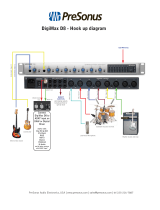
12
3.1 Audio Specification
1-Year Limited Warranty
Product Category Model Transferable
Recording Interfaces
AudioBox iOne, AudioBox iTwo, AudioBox Stereo, AudioBox Studio, AudioBox
USB, AudioBox VSL (1818, 44, 22), FireStudio Project, FireStudio Mobile,
FireStudio Mobile Studio, Music Creation Suite
No
Pre-amplifiers
ADL600, ADL700, BlueTube DP V2, DigiMax D8, Eureka, RC500, StudioChannel,
TubePre V2
No
StudioLive Mixers SL-1642, SL-2442, SL-1602, SLM16.4.2 AI, SLM24.4.2 AI, SLM32.4.2AI No
Monitoring & Controlling
Eris, Central Station Plus, FaderPort, HP4, HP60, Monitor Station, Monitor
Station V2, R65, R80, Sceptre, Temblor
No
Signal Processing ACP88 No
Accessories Covers, Dolly, PRM1 mic, Sub Pole, Breakout Cables, Power Supplies, M10 Kit No
3-Years Limited Warranty
Product Category Model Transferable
Live Sound StudioLive AI 328, 312, 315, 18S Yes
What PreSonus Will Do:
PreSonus will repair or replace, at our sole and absolute option, products covered by this warranty at
no charge for labor or materials. If the product must be shipped to PreSonus for warranty service, the
customer must pay the initial shipping charges. PreSonus will pay the return shipping charges.
How to Get Warranty Service (USA):
1. You must have an active user account with PreSonus and your hardware must be
on le with your account. If you do not have an account, please go to: http://www.
presonus.com/registration and complete the registration process.
2. Contact our Technical Support Department at (225) 216-7887 or log a support ticket at: http://support.
presonus.com. TO AVOID THE POSSIBILITY OF SENDING IN A PRODUCT THAT DOES NOT HAVE A
PROBLEM, ALL SERVICE REQUESTS SHALL BE CONFIRMED BY OUR TECH SUPPORT DEPARTMENT.
3. The return authorization number as well as shipping instructions shall be
provided after your service request is reviewed and conrmed.
4. The product should be returned for service in the original product packaging. Products may be shipped in a
manufactured “ight” or “road” style cases but PreSonus will NOT cover any shipping damage to these cases.
Products that are not shipped in the original product package or a manufactured case may not receive a
warranty repair, at PreSonus’s sole discretion. Depending on the product model and the condition of your
original packaging, your product may not be returned to you in the original packaging. The return shipping
box may be a generic box that has been tted for that model tested if the original gift box is not available.
How to Get Warranty Service (outside of USA):
1. You must have an active user account with PreSonus and your hardware must be
on le with your account. If you do not have an account, please go to: http://www.
presonus.com/registration and complete the registration process.
2. Contact the Technical Support/Service Department for your region at http://www.presonus.com/
buy/international_distributors and follow procedures provided by your PreSonus contact.
Limitation of Implied Warranties:
ANY IMPLIED WARRANTIES, INCLUDING WARRANTIES OF MERCHANTABILITY AND FITNESS FOR A
PARTICULAR PURPOSE, ARE LIMITED IN DURATION TO THE LENGTH OF THIS WARRANTY.
Some states, countries, or provinces do not allow limitations on how long an implied
warranty lasts, so the above limitation may not apply to you.
Exclusion of Damages:
PRESONUS’S LIABILITY FOR ANY DEFECTIVE PRODUCT IS LIMITED TO THE REPAIR OR REPLACEMENT OF THE PRODUCT,
AT PRESONUS’S SOLE OPTION. IF PRESONUS ELECTS TO REPLACE THE PRODUCT, THE REPLACEMENT MAY BE A
RECONDITIONED UNIT. IN NO EVENT WILL PRESONUS BE LIABLE FOR DAMAGES BASED ON INCONVENIENCE, LOSS OF
USE, LOST PROFITS, LOST SAVINGS, DAMAGE TO ANY OTHER EQUIPMENT OR OTHER ITEMS AT THE SITE OF USE, AND, TO
THE EXTENT PERMITTED BY LAW, DAMAGES FOR PERSONAL INJURY, OR ANY OTHER DAMAGES WHETHER INCIDENTAL,
CONSEQUENTIAL OR OTHERWISE, EVEN IF PRESONUS HAS BEEN ADVISED OF THE POSSIBILITY OF SUCH DAMAGES.
Some states, countries, or provinces do not allow limitations on how long an implied
warranty lasts, so the above limitation may not apply to you.
If you have any questions about this warranty or service received, please contact PreSonus (USA) at (225) 216-7887
or one of our authorized international distributors at: http://www.presonus.com/buy/international_distributors.
Product features, design, and specications are subject to change without notice.




















